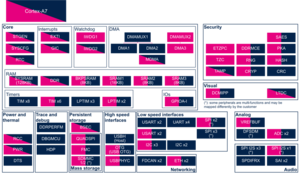1. Article purpose[edit | edit source]
The purpose of this article is to:
- briefly introduce the LTDC peripheral and its main features
- indicate the level of security supported by this hardware block
- explain how each instance can be allocated to the runtime contexts and linked to the corresponding software components
- explain, when necessary, how to configure the LTDC peripheral.
2. Peripheral overview[edit | edit source]
The LCD-TFT (Liquid Crystal Display - Thin Film Transistor) Display Controller peripheral (LTDC) is used to provide an interface to a variety of parallel digital RGB LCD and TFT display panels. The LTDC generates the parallel digital RGB (Red, Green, Blue) signals and the related control signals (horizontal and vertical synchronizations, Pixel Clock and Data Enable).
Moreover, on STM32MP15x lines ![]() , the LTDC is connected to the DSI internal peripheral that provides an interface to communicate with MIPI® DSI-compliant display panels.
, the LTDC is connected to the DSI internal peripheral that provides an interface to communicate with MIPI® DSI-compliant display panels.
2.1. Features[edit | edit source]
Refer to the STM32MP13 reference manuals or STM32MP15 reference manuals for the complete list of features, and to the software components, introduced below, to see which features are implemented.
2.2. Security support[edit | edit source]
2.2.1. On STM32MP13x lines  [edit | edit source]
[edit | edit source]
The LTDC layer2 can be set as secure (under ETZPC control), whereas the layer1 is always non-secure.
2.2.2. On STM32MP15x lines  [edit | edit source]
[edit | edit source]
The LTDC is a non-secure peripheral.
3. Peripheral usage and associated software[edit | edit source]
3.1. Boot time[edit | edit source]
The LTDC is used at boot time for displaying a splash screen thanks to the U-Boot framework [1].
3.2. Runtime[edit | edit source]
3.2.1. Overview[edit | edit source]
The LTDC internal peripheral is allocated to the Arm® Cortex®-A7 non-secure core to be controlled in Linux® by the Linux DRM/KMS framework.
On STM32MP13x lines ![]() , the LTDC can be set secure from ETZPC : this is done at runtime when OP-TEE trusted user interface (Trusted UI) is launched in order to switch the LTDC control and the input layer2 as secure, to display a secure content that cannot be seen from the non-secure world.
, the LTDC can be set secure from ETZPC : this is done at runtime when OP-TEE trusted user interface (Trusted UI) is launched in order to switch the LTDC control and the input layer2 as secure, to display a secure content that cannot be seen from the non-secure world.
Chapter Peripheral assignment describes which peripheral instance can be assigned to which context.
3.2.2. Software frameworks[edit | edit source]
3.2.2.1. On STM32MP13x lines  [edit | edit source]
[edit | edit source]
| Domain | Peripheral | Software components | Comment | |
|---|---|---|---|---|
| OP-TEE | Linux | |||
| Visual | LTDC | OP-TEE Trusted UI | DRM/KMS framework | |
3.2.2.2. On STM32MP15x lines  [edit | edit source]
[edit | edit source]
| Domain | Peripheral | Software components | Comment | ||
|---|---|---|---|---|---|
| OP-TEE | Linux | STM32Cube | |||
| Visual | LTDC | DRM/KMS framework | |||
3.2.3. Peripheral configuration[edit | edit source]
The configuration is applied by the firmware running in the context to which the peripheral is assigned. The configuration can be done alone via the STM32CubeMX tool for all internal peripherals, and then manually completed (particularly for external peripherals), according to the information given in the corresponding software framework article or in the LTDC device tree configuration article for Linux®.
3.2.4. Peripheral assignment[edit | edit source]
3.2.4.1. On STM32MP13x lines  [edit | edit source]
[edit | edit source]
Check boxes illustrate the possible peripheral allocations supported by STM32 MPU Embedded Software:
- ☐ means that the peripheral can be assigned (☑) to the given runtime context.
- ⬚ means that the peripheral can be assigned to the given runtime context, but this configuration is not supported in STM32 MPU Embedded Software distribution.
- ✓ is used for system peripherals that cannot be unchecked because they are statically connected in the device.
Refer to How to assign an internal peripheral to a runtime context for more information on how to assign peripherals manually or via STM32CubeMX.
The present chapter describes STMicroelectronics recommendations or choice of implementation. Additional possiblities might be described in STM32MP13 reference manuals.
| Domain | Peripheral | Runtime allocation | Comment | ||
|---|---|---|---|---|---|
| Instance | Cortex-A7 secure (OP-TEE) |
Cortex-A7 non-secure (Linux) | |||
| Visual | LTDC | LTDC | ☐ | ☐ | Shareable (multiple choices supported) |
3.2.4.2. On STM32MP15x lines  [edit | edit source]
[edit | edit source]
Check boxes illustrate the possible peripheral allocations supported by STM32 MPU Embedded Software:
- ☐ means that the peripheral can be assigned (☑) to the given runtime context.
- ✓ is used for system peripherals that cannot be unchecked because they are statically connected in the device.
Refer to How to assign an internal peripheral to a runtime context for more information on how to assign peripherals manually or via STM32CubeMX.
The present chapter describes STMicroelectronics recommendations or choice of implementation. Additional possiblities might be described in STM32MP15 reference manuals.
| Domain | Peripheral | Runtime allocation | Comment | |||
|---|---|---|---|---|---|---|
| Instance | Cortex-A7 secure (OP-TEE) |
Cortex-A7 non-secure (Linux) |
Cortex-M4 (STM32Cube) | |||
| Visual | LTDC | LTDC | ☐ | |||
4. How to go further[edit | edit source]
Refer to STM32 LTDC application note (AN4861) [2] for a detailed description of the LTDC peripheral and applicable use-cases.
Even if this application note is related to STM32 microcontrollers, it also applies to STM32 MPUs.
5. References[edit | edit source]

